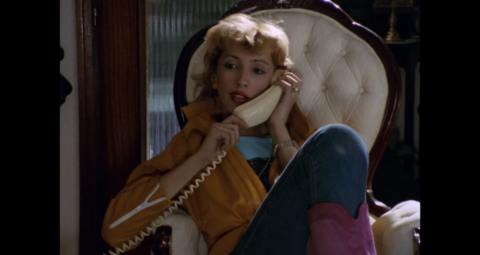If you want to make a good documentary about someone’s inner life — how they think, how they feel, how they dream — it’s best to simply let them talk for themselves. That’s precisely what Antonio Giménez Rico does in the 1983 trans classic Dressed In Blue, following the hopes and dreams of several transgender women as they navigate post-Franco Spain.
It opens in the dark streets of Madrid. Almodóvar country. Women are hustling in the streets, talking to men as they drive their cars, looking for quick sex. The police suddenly turn up. The women scarper. The picture freezes and the text tells us that while this situation might be staged, this is the lived-in reality for many trans women in the 80s. From here, Rico uses a lovely luncheon framing device, following these women as they talk to each other about hustling, about breasts, about whether or not to have surgery, before settling into mini segments on each one, captured in loving and wonderful detail.
Recently restored to its full glory, the film bursts with beauty, fabulousness and a genuinely empathetic gaze, avoiding Dhontesque fetishisation in favour of a true desire to understand how these women present themselves to the world. Rico makes use of many mirror shots, allowing us to watch them as they get ready, put on their make-up, dress and undress, even tuck in their penises, all without the titillation that can often accompany contemporary films about trans bodies. (But there is a gratuitous surgery sequence, which while informative, did feel unnecessary. Still, a generous reading might be that Rico wanted to show the full spectrum of trans existence, including the nuts and bolts of gender reassignation.)
Many of the women are sex workers. Some because they enjoy it, others because it appears that this is the only path allowed to them in a world filled with blatant discrimination. They seem to fulfil a transmisogynist paradox at the heart of contemporary society — women who are shunned for flouting gender norms are also seen as highly-sexualised objects for these very same transgressions.
The conventional wisdom is that every age is more progressive than the next. But I couldn’t help but feel when watching a film like this, made with such care — and curiosity — by a cisgender director, that when trans women did become more visible in the 80s and 90s, and their very lives hadn’t become a source of existential debate yet, that everyday people did want to know more and were more curious as a result. This is not a film about discourse, but about real lives. Dressed In Blue understands these women as everyday people, including a stand-out confrontation with one’s ex-wife which manages to both portray societal issues and present our heroine as a singularly flawed individual.
As these women picture a future without strife and oppression, it becomes doubly sad to think that as trans people have become more prominent in popular culture, especially in particularly progressive Spain, the world at large, poisoned by social media and prominent figures in the public discourse, has not become particularly more understanding. Let’s hope the next forty-three years are better than the last.

Redmond is the editor-in-chief of Journey Into Cinema.
